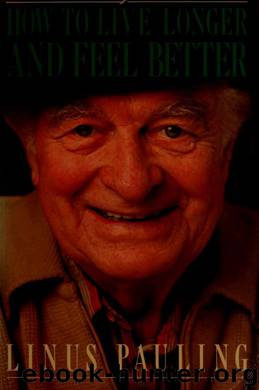How to live longer and feel better by Pauling Linus 1901-1994

Author:Pauling, Linus, 1901-1994
Language: eng
Format: epub
Tags: Orthomolecular therapy, Orthomolecular Therapy, Mégavitaminothérapie, Vitaminversorgung
Publisher: New York : W.H. Freeman
Published: 1986-12-26T05:00:00+00:00
are sound arguments that support the claims made by the Shutes about the value of vitamin E for preventing and controlling coronary heart disease and other diseases.
Haeger pointed out that the sharp pains in the calves of the legs that are experienced by patients with peripheral occlusive arterial disease after they have walked some distance are analogous to the sharp heart pains (angina) of patients with coronary heart disease. In each instance the pain results from a deficiency of oxygen—the working muscle has used up the oxygen faster than it can be brought to the muscle of the leg or heart through the clogged arteries. There is no doubt that the muscle pain is relieved by vitamin E (as are also the muscle cramps that some people experience). It is, accordingly, reasonable that the angina of the patient with heart disease would also be relieved by vitamin E, as described by Wilfrid Shute and Evan Shute in their books.
It was recognized more than fifty years ago that a low intake of vitamin E leads to muscular dystrophy, a disorder of the skeletal muscles characterized by weakness similar to that caused by a deficiency of vitamin C (the studies of vitamin E and muscular dystrophy have been discussed by Pappenheimer, 1948). The difficulty in walking experienced by patients with peripheral occlusive arterial disease may result in part from a low vitamin-E concentration in the muscles and in part from a decreased rate of delivery of oxygen to them. The damage to the muscles when vitamin E is in short supply may be the result of oxidation of the unsaturated lipids, which are protected by the fat-soluble antioxidant vitamin E when it is present in sufficient concentrations.
Several kinds of hereditary muscular dystrophies are known. For the most part their nature is not thoroughly understood, and there is no specific therapy recommended for them. Myasthenia gravis is treated by inhibitors of cholinesterase, corticosteroids, and surgical removal of the thymus gland. The medical authorities do not mention the possible value of vitamins in controlling muscular dystrophies. The evidence about the involvement of vitamin E and vitamin C as well as B 6 and other vitamins in the functioning of muscles suggests that the optimum intakes of these nutrients should be of value to the patients. So far as I know, no careful study of an increased vitamin intake for patients with hereditary muscular dystrophy has been reported.
Vitamin E, the fat-soluble antioxidant vitamin, and vitamin G, the water-soluble antioxidant vitamin, collaborate in protecting the blood vessels and other tissues against damage by oxidation. They slow down the process of deterioration of the body with the passage of time and help to prevent cardiovascular disease. They have value as an adjunct to appropriate conventional therapy in the treatment of cardiovascular disease and other diseases.
Download
This site does not store any files on its server. We only index and link to content provided by other sites. Please contact the content providers to delete copyright contents if any and email us, we'll remove relevant links or contents immediately.
| Administration & Medicine Economics | Allied Health Professions |
| Basic Sciences | Dentistry |
| History | Medical Informatics |
| Medicine | Nursing |
| Pharmacology | Psychology |
| Research | Veterinary Medicine |
Dynamic Alignment Through Imagery by Eric Franklin(4119)
Body Love by Kelly LeVeque(3017)
Barron's AP Calculus by David Bock(1780)
EMT Exam For Dummies with Online Practice by Arthur Hsieh(1654)
The Juice Lady's Remedies for Asthma and Allergies by Cherie Calbom(1607)
Fitness Walking For Dummies by Liz Neporent(1532)
Flight by Elephant(1487)
Extremes: Life, Death and the Limits of the Human Body by Fong Kevin(1485)
McGraw-Hill Nurses Drug Handbook by Patricia Schull(1466)
The Natural First Aid Handbook by Brigitte Mars(1434)
Tell by Major Margaret Witt(1381)
Skin by Unknown(1372)
Seeing Voices by Oliver Sacks(1362)
Born to Walk by James Earls(1284)
The Yoga Bible by Christina Brown(1264)
Cracking the Nursing Interview by Jim Keogh(1254)
First Aid for Colleges and Universities (10th Edition) by Mistovich Joseph J. & Limmer Daniel J. & Karren Keith J. & Hafen Brent Q(1233)
The Advantage by Lencioni Patrick M(1172)
Living Ready Pocket Manual - First Aid: Fundamentals for Survival by James Hubbard(1163)
